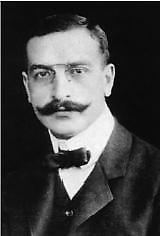 | ||
Parents Salomon Gräfenberg, Minna Gräfenberg Born 26 September 1881 (age 76), Adelebsen, Germany Died 28 October 1957 (aged 76), New York, New York, United States Similar Beverly Whipple, R G Waldeck, Heinz Thilo | ||
Ernst Gräfenberg (September 26, 1881 in Adelebsen near Göttingen, Germany – 28 October 1957 in New York City, United States) was a German-born physician (medical doctor) and scientist. He is known for developing the intrauterine device (IUD), and for his studies of the role of the woman's urethra in orgasm. The G-spot is named after him.
Contents
Career
Gräfenberg studied medicine in Göttingen and Munich, earning his doctorate on 10 March 1905. He began working as a doctor of ophthalmology at the university of Würzburg, but then moved to the Department of Obstetrics and Gynaecology at the University of Kiel, where he published papers on cancer metastasis (the "Gräfenberg theory"), and the physiology of egg implantation. In 1910 Gräfenberg worked as a gynaecologist in Berlin, and by 1920 was quite successful, with an office on the Kurfurstendamm. He was chief gynaecologist of a municipal hospital in Britz, a working class Berlin district, and was beginning scientific studies of the physiology of human reproduction at Berlin University.
During the First World War, he was a medical officer, and continued publishing papers, mostly on human female physiology. In 1929 he published his studies of the "Gräfenberg ring", the first IUD for which there are usage records.
17th-century, Dutch physician Regnier de Graaf described female ejaculation and referred to an erogenous zone in the vagina that he linked with the male prostate; this zone was later reported by Gräfenberg. The term "G-Spot" was coined by Addiego et al. in 1981, named after Gräfenberg, even though Gräfenberg's 1940s research was dedicated to urethral stimulation; In 1950, Gräfenberg stated, "An erotic zone always could be demonstrated on the anterior wall of the vagina along the course of the urethra."
When Nazism assumed power in Germany, Gräfenberg, a Jew, was forced in 1933 to resign as head of the department of gynaecology and obstetrics in the Berlin-Britz municipal hospital. In 1934, Hans Lehfeldt attempted to persuade him to leave Nazi Germany; he refused, believing that since his practice included wives of high Nazi officials, he would be safe. He was wrong, and was arrested in 1937 for having smuggled out a valuable stamp from Germany. Margaret Sanger ransomed him from Nazi prison, and he was finally allowed to leave in 1940, whereupon he went to the US and opened a practice in New York City.
Private life
Gräfenberg was the son of Salomon Gräfenberg (1834-1918) and Minna Gräfenberg (née Eichenberg; 1845-1910). Ernst's father owned an iron wares business in Adelebsen, and served as the head of the Jewish community there from 1868 to 1882, and as an Adelebsen community council member (Bürgervorsteher) from 1889 to 1893. In 1893 the family moved to Göttingen, where Ernst attended the municipal high school, or Gymnasium, later known as the Max-Planck-Gymnasium.
Gräfenberg was briefly married to writer Rosie Waldeck. He died on 28 October 1957 in New York City.
